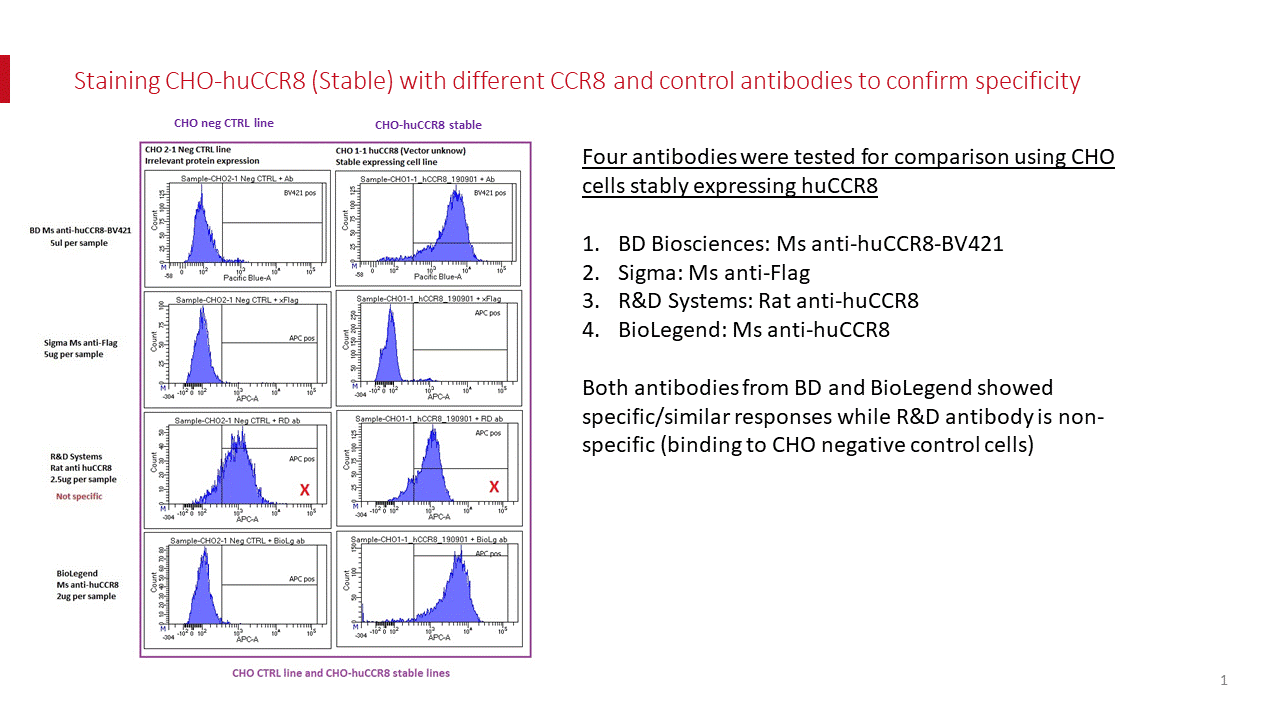Human CCR8 Antibody
Human CCR8 Antibody Summary
*Small pack size (-SP) is supplied either lyophilized or as a 0.2 µm filtered solution in PBS.
Applications
Please Note: Optimal dilutions should be determined by each laboratory for each application. General Protocols are available in the Technical Information section on our website.
Scientific Data
 View Larger
View Larger
Detection of CCR8 in Human Blood by Flow Cytometry. Human peripheral blood cells were stained with (A) Rat Anti-Human CCR8 Monoclonal Antibody (Catalog # MAB1429) or (B) isotype control antibody (Catalog # MAB0061) followed by anti-Rat IgG APC-conjugated Secondary Antibody (Catalog # F0113) and Mouse anti-Human CD14 PE-conjugated Monoclonal Antibody (Catalog # FAB3832P). View our protocol for Staining Membrane-associated Proteins.
 View Larger
View Larger
Chemotaxis Induced by CCL1/I‑309 and Neutralization by Human CCR8 Antibody. Recombinant Human CCL1/I-309 (Catalog # 272-I) chemoattracts the BaF3 mouse pro-B cell line transfected with human CCR8 in a dose-dependent manner (orange line). The amount of cells that migrated through to the lower chemotaxis chamber was measured by Resazurin (Catalog # AR002). Chemotaxis elicited by Recombinant Human CCL1/I-309 (20 ng/mL) is neutralized (green line) by increasing concentrations of Rat Anti-Human CCR8 Monoclonal Antibody (Catalog # MAB1429). The ND50 is typically 0.01-0.05 µg/mL.
Reconstitution Calculator
Preparation and Storage
Background: CCR8
CCR8 (C-C chemokine receptor 8; previously called CKR-L1 or TER1 and designated CD198) is a 41-43 kDa member of the GPCR 1 family of transmembrane proteins. CCR8 is expressed on vascular smooth muscle cells, monocytes, eosinophils, peritoneal macrophages, thymocytes, CD8+ T cells, Langerhans cells and neurons. CCL1/TCA3 and vMIP-1 are known agonists for CCR8. Human CCR8 is a 7-transmembrane protein that is 355 amino acids (aa) in length. It contains a 35 aa N-terminal extracellular domain plus a 51 aa C-terminal cytoplasmic tail. Over aa sequences 1-33 and 92-105 collectively, human and mouse CCR8 share 64% aa sequence identity.
Product Datasheets
Citations for Human CCR8 Antibody
R&D Systems personnel manually curate a database that contains references using R&D Systems products. The data collected includes not only links to publications in PubMed, but also provides information about sample types, species, and experimental conditions.
3
Citations: Showing 1 - 3
Filter your results:
Filter by:
-
Distribution, persistence, and efficacy of adoptively transferred central and effector memory-derived autologous Simian Immunodeficiency Virus-specific CD8(+) T cell clones in rhesus macaques during acute infection.
Authors: Minang JT, Trivett MT, Bolton DL, Trubey CM, Estes JD, Li Y, Smedley J, Pung R, Rosati M, Jalah R, Pavlakis GN, Felber BK, Piatak M, Roederer M, Lifson JD, Ott DE, Ohlen C
J. Immunol., 2009-11-30;184(1):315-26.
Species: Primate - Macaca mulatta (Rhesus Macaque)
Sample Types: Whole Cells
Applications: Flow Cytometry -
Trafficking, persistence, and activation state of adoptively transferred allogeneic and autologous Simian Immunodeficiency Virus-specific CD8(+) T cell clones during acute and chronic infection of rhesus macaques.
Authors: Bolton DL, Minang JT, Trivett MT, Song K, Tuscher JJ, Li Y, Piatak M, O'Connor D, Lifson JD, Roederer M, Ohlen C
J. Immunol., 2009-11-30;184(1):303-14.
Species: Primate - Macaca mulatta (Rhesus Macaque)
Sample Types: Whole Cells
Applications: Flow Cytometry -
The majority of human peripheral blood CD4+CD25highFoxp3+ regulatory T cells bear functional skin-homing receptors.
Authors: Hirahara K, Liu L, Clark RA, Yamanaka K, Fuhlbrigge RC, Kupper TS
J. Immunol., 2006-10-01;177(7):4488-94.
Species: Human
Sample Types: Whole Cells
Applications: Flow Cytometry
FAQs
-
Are there special considerations for Flow Cytometry using Human CCR8 Antibody, Catalog # MAB1429 and FAB1429?
The staining with this antibody is temperature dependent; it will stain at 4 C and room temperature, however, staining is stronger at 37 C.
Reviews for Human CCR8 Antibody
Average Rating: 1 (Based on 1 Review)
Have you used Human CCR8 Antibody?
Submit a review and receive an Amazon gift card.
$25/€18/£15/$25CAN/¥75 Yuan/¥1250 Yen for a review with an image
$10/€7/£6/$10 CAD/¥70 Yuan/¥1110 Yen for a review without an image
Filter by:
We ran standard FACS staining on human CCR8 transfected CHO and HEK293 cells. The antibody did not bind specifically, at all. Standard controls, including other antibodies, worked. We did the experiment with and without a N'terminal tag; same results.



